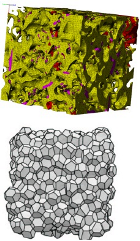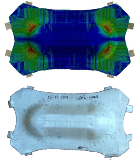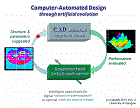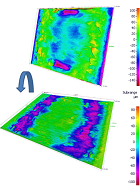Materials, Design and Manufacturing
The Materials, Design and Manufacturing theme focuses on the use of numerical computation in understanding and optimising both material properties and design and manufacture processes. Materials of particular interest include: advanced, smart and nano-composites, adhesives, technical textiles and porous materials. Strong emphasis is placed on predicting the macro-scale properties of these materials from the underlying micro- and meso-structure. Understanding the role of the manufacture process in determining material behaviour is a key concern. The Design aspect of the research theme aims to reverse the typical design process by turning ‘design problems’ into ‘simulation problems’; a method known as computer-automated design. Here biologically-inspired, intelligent machine-learning algorithms are developed to allow manual design questions to be solved using faster, more efficient computer-controlled design codes. The Materials and Design themes can be combined to address issues in Manufacturing where the interplay between material behaviour and manufacture process determines both the quality and cost of the final products.
Research across all these sub-themes is funded through various sources. Application areas for the research are broad including aeronautical, biomedical, energy, marine, military and automotive engineering.
Research topics
Composite Materials
Advanced Manufacture
Computer-Automated Design (CAutoD)
Staff
Quick Links
Composite Materials
Dr Philip Harrison, Dr Daniel Mulvihill
Composite materials are an exciting and fast-moving research topic. Developments in this area are driving economic growth and transforming society in a number of fundamental ways; from the reduction of carbon emissions through light-weighting, to the development of multi-functional smart composites that can self-sense and self-heal damage for low-cost in-service maintenance. New developments in composite materials provide new possibilities in engineering design and their introduction brings the challenge of understanding and controlling their properties. Research covers a broad spectrum of topics, examples currently under investigation include:
- Forming mechanics of advanced composites
- Digital microstructure generation for cellular materials
- Stochastic modelling of fibre orientation variability in advanced composite laminates
- Dynamic response of smart laminates
- Tribology of composite materials and composite joints
- Experimental mechanics and computational modelling of composite materials
- Strength and toughness of composite materials
- Nanocomposites (e.g. using carbon nanotubes and graphene

Advanced Manufacture
Dr Philip Harrison, Dr Daniel Mulvihill
Advanced manufacturing is one of the pillars on which the economic recovery of the UK will be built. The need to manufacture high quality products at low cost is crucial to if the UK is to be competitive in the global market. Implicit in this challenge is the development of automated high rate production technologies to reduce costs and also the introduction of new Computer Aided Engineering (CAE) tools to reduce or eliminate trial and error approaches to design and manufacture. Our group’s activities aim to address these challenges and look to understand and predict the complex relationship between manufacture process and final product quality and properties. Example topics currently under investigation include:
- Thermoforming of advanced composites,
- Manufacture of self-sensing and self-healing structural foams,
- Low cost manufacture of steered-fibre laminates.

Computer-Automated Design (CAutoD)
Dr Cindy Goh (UoG Singapore), Prof Idris Lim (UoG Singapore)
CAutoD reverses a 'design' problem to a 'simulation' problem and hence automates ‘virtual prototyping’ through intelligent search using biologically-inspired machine learning. It optimizes and accelerates an otherwise human trial-and-error process prior to physical prototyping and transforms the traditional product or service development cycle
from: concept → build → test → fix
to: concept → optimise or invent → build.
Research is on-going to develop biologically-inspired and intelligent systems engineering tools, to improve the performance of a CAutoD system through enhanced interactions with the design and learning environment systematically.
CAutoD is applied to a wide range of design problems, including:
- Virtual prototyping for microwave-enabled greener internal combustion engines: it was shown that if microwave is used to ignite the fuel-air mixture, fuel consumption and emission of petrol vehicles could be reduced by 30%. The role of the microwave plays in the ignition process is studied in computer simulations using CAutoD.
- Wireless sensors network modelling and optimisation: The research develops novel and intelligent techniques to holistically model, simulate and optimise the network behaviours and performance such that the associated network level challenges will be overcome.
- Optimal wind power generation system design: optimal digital prototypes of wind power generating systems under practical constraints are developed such that a physical prototype is not necessary for every test.
- Optimal solar panel modeling and design: optimal digital prototypes of bifacial PV panel modeling considering optical losses are developed and validated with indoor flash test, as well as outdoor monitoring results.
- Automated smart design of efficient hull form through hybrid evolutionary algorithm and morphing: The focus of this research is on a hybrid evolutionary algorithm (EA) and morphing approach, which combines EA with a novel morphing-based shape variation approach to optimise and automate the entire hull form design process from problem formulation to creation of new optimal solutions. Results show that this approach is capable of producing more efficient designs within significantly shorter time. It is envisioned that the proposed approach can be extended to automobile and aircraft design.

Tribology
Tribology is often described as the science of friction, wear and lubrication. It encompasses all scenarios involving contact between materials. Tribology is critical in terms of energy conservation as billions of dollars are lost annually due to frictional energy dissipation and wear. Most mechanical systems rely on sophisticated tribological understanding in order to operate effectively. Research focus at Glasgow is directed towards developing the physical understanding of contacting materials and encompasses contact mechanics, surface topography, experimental tribology and contact modelling. Applications of tribology are widespread across the engineering world (examples include contact between aero-engine components, fibre-matrix contact within composite materials, contact in metal and composites forming, mechanical joints, knee replacements, MEMS devices and many more). Current PhD opportunities exist in the area of: tribology of nano and micro structured surfaces, tribology of metal and composites forming and in the area of mechanical joints.


